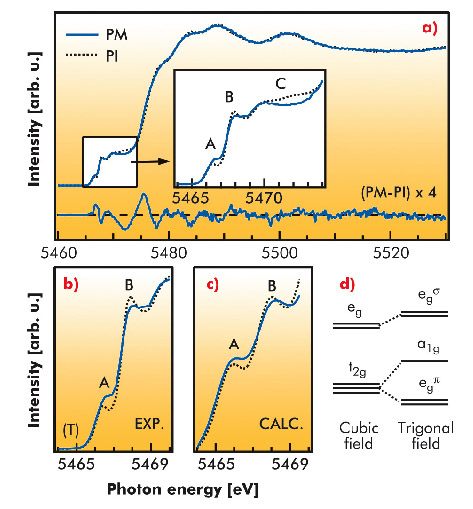- Home
- Users & Science
- Scientific Documentation
- ESRF Highlights
- ESRF Highlights 2010
- Dynamics and extreme conditions
- Inequivalent routes across the Mott transition in V2O3 explored by X-ray absorption
Inequivalent routes across the Mott transition in V2O3 explored by X-ray absorption
Some materials exhibit metal-insulation transitions (MIT) without changes in crystal structure or long-range magnetic order. These phenomena, known as Mott-Hubbard transitions, are a fundamental signature of strong electronic correlations resulting from the interplay of the on-site Coulomb interaction U and bandwidth W. A particularly mind-boggling situation happens at intermediate U/W strength, though progress has been made recently thanks to dynamical mean field theory (DMFT) approaches [1]. Cr-doped vanadium sesquioxide V2O3 appears as a textbook case for investigating such MIT. At ambient conditions, it is a paramagnetic insulator (PI) that is driven to a paramagnetic metal (PM) or an antiferromagnetic insulator (AFI) according to doping level (x), temperature (T) or pressure (P). The correlated nature of the transition in V2O3 has been confirmed by the observation of a quasiparticle at the Fermi level with bulk-sensitive photoemission spectroscopy [2], while soft X-ray absorption has revealed the multi-orbital, S=1, nature of the ground state [3] in contrast to earlier, single electron models. The underlying mechanism of the MIT, however, is still poorly understood and calls for further investigations throughout the entire phase diagram.
 |
|
Fig. 20: V-K edge in V2O3 at the metal-insulator transition: Experiment and calculations. |
In a recent series of experiments carried out at beamlines ID26 and BM30, we have probed the electronic properties of V2O3 by X-ray absorption spectroscopy at the V-edge. The spectra were acquired in the so-called “high-resolution” partial fluorescence yield (PFY) mode by monitoring the V Ka line intensity while varying the incident energy through the K-edge. We used a Ge crystal analyser as energy filter operated in Rowland circle geometry. The gain in resolution is especially appreciable in the pre-edge region that bears the critical information. Figure 20 illustrates our main results. The left panel shows the V-K edge measured at the T-induced MIT. The spectral changes mostly occur in the pre-edge region (features A to C) that directly relates to the d electronic properties. Discarding feature C of p-d hybridised character, the MIT mainly entails a change of the A/B intensity ratio. Aided by DMFT calculations, we understand these changes by the increase of the occupation, in the ground state, of the a1g crystal-field split orbital, i.e. of the incoherent upper Hubbard band, at the transition. Interestingly, an entirely different behaviour is observed in the P-driven Mott transition. Figure 21 shows the pre-edges obtained by following different “pathways” in the phase diagram through the MIT as illustrated in the inset. Instead of a change of intensity, P yields an energy shift of the pre-edge features. The results, best visualised in the difference spectra, provide evidence for the equivalent roles of T and doping – also confirmed by photoemission – while P clearly steps out as a unique thermodynamics parameter. Thus, two different mechanisms for the MIT can be proposed: T and doping could act on the crystal field splitting through electron correlations while P more directly affects the electronic bandwidth by the compression of the lattice. There is evidence as well that both T and doping induce a metallic phase intermixed with insulating patches while pressure yields almost pure metallic character. We believe our finding may apply to other strongly correlated systems, with pressure opening inequivalent pathways through their phase diagrams.
 |
|
Fig. 21: Role of external parameters: The spectra provide evidence of the non-equivalence between P, T and doping (x) driven transitions. a) V K-edge absorption spectra, b) differences of absorption spectra, c) photoemission spectra, d) difference of photoemission spectra. |
Principal publication and authors
F. Rodolakis (a,b), P. Hansmann (c,d), J.-P. Rueff (b,e), A. Toschi (c), M.W. Haverkort (d), G. Sangiovanni (c), A. Tanaka (f), T. Saha-Dasgupta (g), O.K. Andersen (d), K. Held (c), M. Sikora (h), I. Alliot (h,i), J.-P. Itié (b), F. Baudelet (b), P. Wzietek (a), P. Metcalf (j) and M. Marsi (a), PRL 104, 047401 (2010).
(a) LPS, Orsay (France)
(b) Synchrotron SOLEIL (France)
(c) ISSP, Vienna (Austria)
(d) MPI, Stuttgart (Germany)
(e) LCPMR, Paris (France)
(f) Hiroshima University (Japan)
(g) Bose Center for Basic Sciences, Kolkata (India)
(h) ESRF
(i) CEA (Grenoble)
(j) Purdue University (USA)
References
[1] A.I. Poterayev et al., Phys. Rev. B 76, 085127 (2007).
[2] F. Rodolakis et al., Phys. Rev. Lett 102, 066805 (2009) and references therein.
[3] J. Park et al., Phys. Rev. B 61, 11506 (2000).



